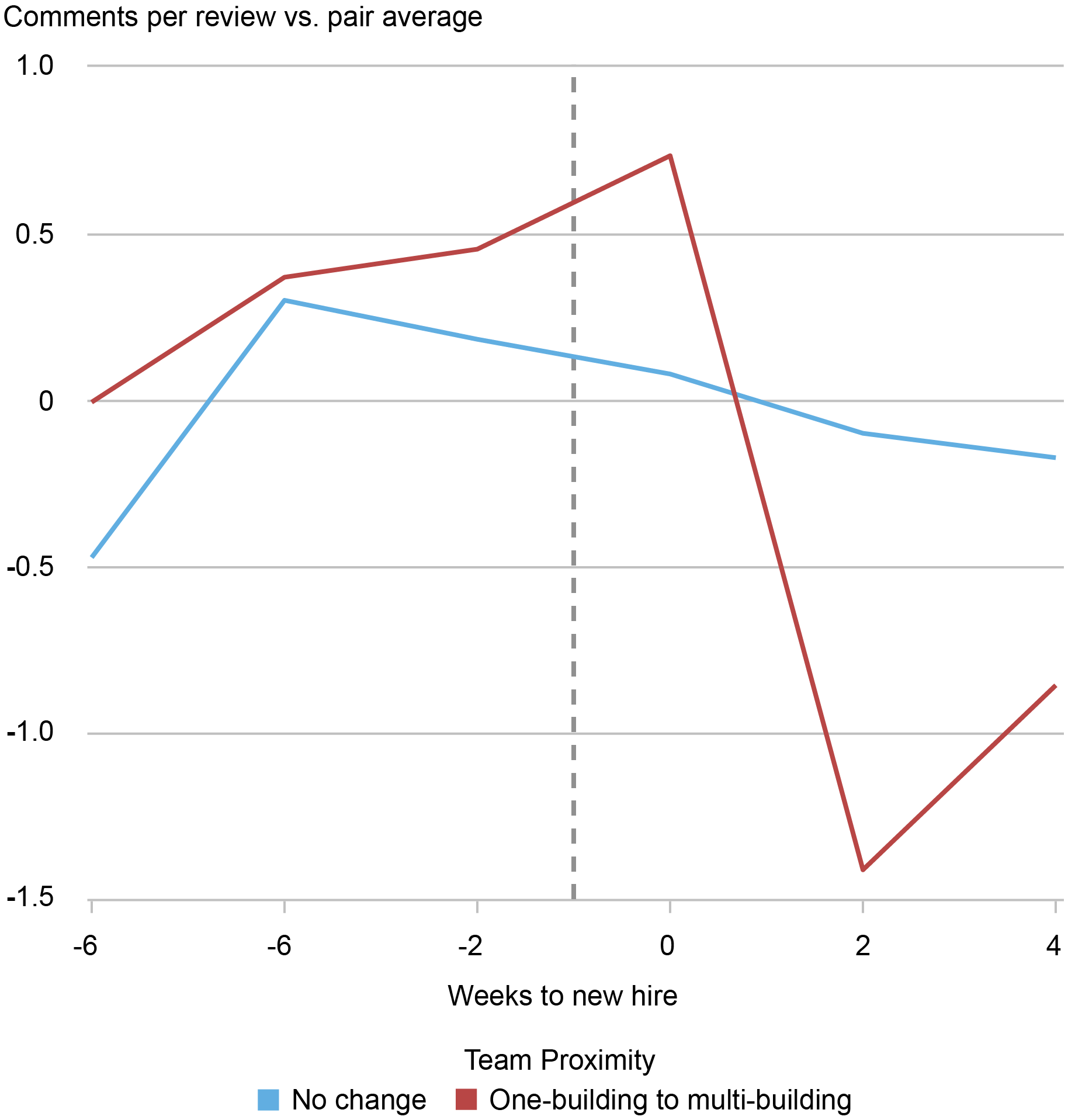The Power of Proximity: How Working beside Colleagues Affects Training and Productivity – Liberty Street Economics
[ad_1]
Firms remain divided about the value of the office for “office” workers. Some firms think that their employees are more productive when working from home. Others believe that the office is a key place for investing in workers’ skills. In this post, which is based on a recent working paper, we examine whether both sides could be right: Could working in the office facilitate investments in workers’ skills for tomorrow that diminish productivity today?
We examine the impact of proximity to coworkers on workers’ productivity and mentorship in the context of software engineers at a Fortune 500 firm. The firm shared data with us on the number of programs engineers write and the text of the feedback they receive on their computer code. As is industry standard, software engineers review one another’s code online prior to deployment. This peer review process not only aids in identifying bugs but also helps teach engineers how to write better code in the future. Thus, this feedback gives us a concrete measure of mentorship.
At the firm, engineers varied in their proximity to one another even before COVID-19. The firm has two buildings on its main engineering campus, several blocks apart. Prior to COVID-19, some teams were assigned desks all in one building, while others spanned the buildings. Desk positions alter team dynamics. When the offices were open, engineers on one-building teams held daily stand-up meetings in person. For engineers on multi-building teams, these meetings usually occurred online. As a result, these teams operated more like remote teams even when the offices were open. To identify the causal effects of proximity, we compare the differences between one- and multi-building teams when the offices were open and the differential changes when the offices were closed.
Effects of Proximity on Mentorship
We find that proximity increases mentorship. While offices were open, engineers on one-building teams received 22 percent more comments on their code than did engineers on multi-building teams, as shown in the left side of the chart below. Once the offices closed and everyone worked remotely, the gap largely disappeared, as seen in the right side of the chart. This feedback reflects mentorship: sitting near teammates primarily affects feedback received by junior engineers and given by engineers who have been at the firm longer.
Engineers Working Together Received More Feedback Than Those on Multi-Building Teams

Source: Authors’ calculations based on data from a Fortune 500 firm covering the period from August 2019 to December 2020.
Notes: The chart shows the online feedback received by engineers on one-building teams and multi-building teams around the COVID-19 office closures (dashed vertical line). Figures reflect raw averages.
Engineers sitting near teammates receive more feedback partly because they ask more follow-up questions. These additional questions and clarifications highlight how face-to-face interaction complements—rather than substitutes for—online communication. Indeed, our analysis of online feedback likely delivers a lower bound on proximity’s total effect on mentorship insofar as physically sitting together also facilitates face-to-face conversation.
We find that having even one distant teammate dampens mentorship between teammates sitting together. These externalities can explain about a third of proximity’s impact. Furthermore, pre-pandemic, when a new teammate was assigned a desk in another building—flipping a one-building team to a multi-building team—feedback among same-building teammates (who predated the new hire) declined, as shown by the red line in the chart below. By contrast, new hires in the same building had no such impact, as shown by the blue line. Accommodating distant teammates by, for example, moving in-person meetings online, has substantial negative effects on even proximate teammates.
Assigning New Hire to Different Building Decreased Feedback among Workers Who Sat Together

Source: Authors’ calculations based on data from a Fortune 500 firm covering the period from August 2019 to December 2020.
Notes: The chart shows the impact of a new hire that converts the team from a one-building team to a multi-building team versus a new hire that does not change the distribution of the team, focusing on the pre-existing relationships between teammates in the same building.
Effects of Proximity on Output, Pay, and Quits
We find, however, that mentorship isn’t free: instead, proximity to coworkers decreases output. Engineers on one-building teams wrote fewer programs than those on multi-building teams while the offices were open, and this differential narrowed once the offices closed. Our estimate suggests that proximity reduces programs written per month by 23 percent. The effects on output are present for both junior and senior engineers but are particularly pronounced for senior engineers, who provide most of the mentoring.
Proximity also affects workers’ career outcomes. Junior workers on one-building teams—who are more focused on building their skills and thus produce less output—were 5 percentage points less likely to receive a pay raise. However, once the offices shut down and mentorship equalized across teams, formerly one-building engineers benefited from the mentorship that they received: they were 7 percentage points more likely to receive a pay raise.
Quits also reflect the impact of proximity. Before COVID-19, quits were relatively rare at this firm. However, with the rise of remote work, quits increased as it became easier to switch to higher-paying Silicon Valley tech firms without relocating from this firm’s East Coast city. Notably, workers who had been trained on one-building teams saw a 1.2 percentage point greater increase in quits, about twice that of engineers trained on multi-building teams. Engineers on one-building teams were more likely to move to roles at firms that offer higher salaries (according to Glassdoor). These results are consistent with the greater training on one-building teams giving engineers the skills they need to secure higher-paying jobs elsewhere. As with pay raises, the effects are larger for women. We do not see the same impacts on firings; while the impacts are not statistically significant, they suggest that workers on one-building teams are less likely to be fired once the offices close.
Who Works in the Office?
Finally, we examine who works at the office versus who works from home. Pre-pandemic, workers’ locations were consistent with the firm placing a high priority on training. Those most involved in mentorship were most likely to be office-based: this was true both for the junior workers receiving the most mentorship and for the senior workers and managers giving the most mentorship. This aligns with national trends in 2022-23, where young workers and older workers are the most likely to have returned to the office, even among those who do not have children. Moreover, when proximity was impossible during the pandemic, the firm moved away from hiring very junior engineers toward hiring workers with more training. While this change could be influenced by many factors, it is consistent with the idea that when the firm faces challenges in facilitating proximity, it decides to “buy” talent instead of “build” it.
Together, these results suggest that there may be a “now versus later” tradeoff when considering the location of work. Working from home may yield short-term gains in output, but this productivity may come at the cost of workers’ long-run skill development. It will be important to analyze whether hybrid work can offer the best of both worlds or whether a tradeoff will remain between short-run output and long-run development.

Natalia Emanuel is a research economist in Equitable Growth Studies in the Federal Reserve Bank of New York’s Research and Statistics Group.
Emma Harrington is an assistant professor at the University of Virginia.
Amanda Pallais is a professor of economics at Harvard University.
How to cite this post:
Natalia Emanuel, Emma Harrington, and Amanda Pallais, “The Power of Proximity: How Working beside Colleagues Affects Training and Productivity,” Federal Reserve Bank of New York Liberty Street Economics, January 18, 2024, https://libertystreeteconomics.newyorkfed.org/2024/01/the-power-of-proximity-how-working-beside-colleagues-affects-training-and-productivity/.
Disclaimer
The views expressed in this post are those of the author(s) and do not necessarily reflect the position of the Federal Reserve Bank of New York or the Federal Reserve System. Any errors or omissions are the responsibility of the author(s).
[ad_2]


